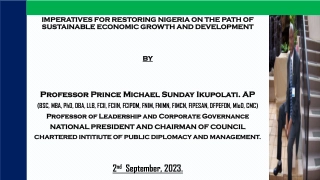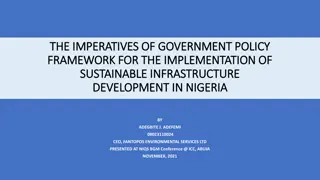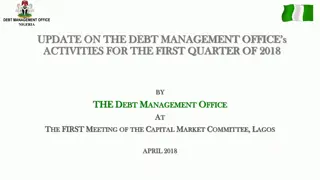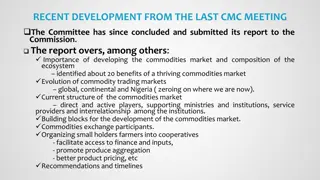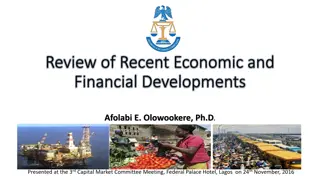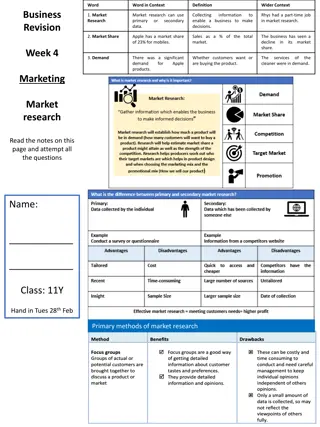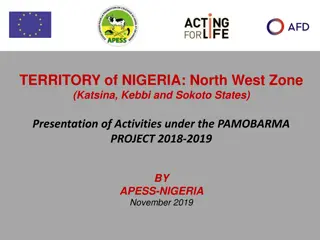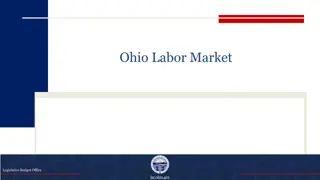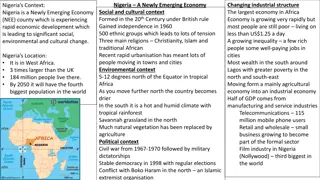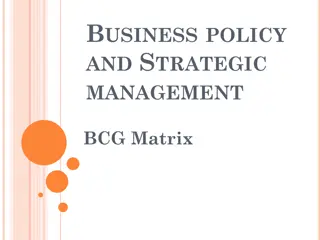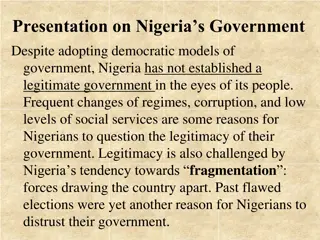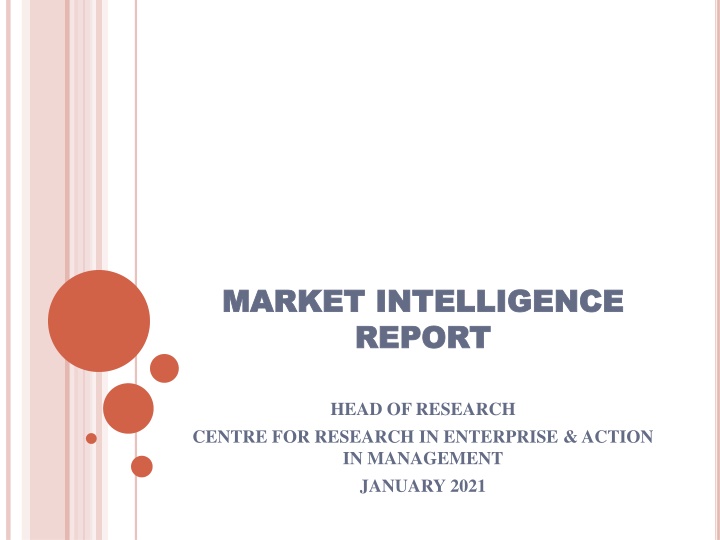
Insights on Nigeria's Economic Trends and Market Developments January 2021
The report highlights key economic indicators and market activities in Nigeria for January 2021. It covers the Monetary Policy Committee's decisions, Company Income Tax trends, Treasury Bills issuance, and the Bank of Industry's loan syndication transaction, offering a comprehensive overview of the Nigerian economy. The analysis provides valuable insights for investors, policymakers, and business stakeholders navigating the country's economic landscape.
Download Presentation

Please find below an Image/Link to download the presentation.
The content on the website is provided AS IS for your information and personal use only. It may not be sold, licensed, or shared on other websites without obtaining consent from the author. If you encounter any issues during the download, it is possible that the publisher has removed the file from their server.
You are allowed to download the files provided on this website for personal or commercial use, subject to the condition that they are used lawfully. All files are the property of their respective owners.
The content on the website is provided AS IS for your information and personal use only. It may not be sold, licensed, or shared on other websites without obtaining consent from the author.
E N D
Presentation Transcript
MARKET INTELLIGENCE MARKET INTELLIGENCE REPORT REPORT HEAD OF RESEARCH CENTRE FOR RESEARCH IN ENTERPRISE & ACTION IN MANAGEMENT JANUARY 2021
NIGERIAN ECONOMY The Monetary Policy Committee (MPC), of the CBN in the month of January 2021, voted to unanimously keep the Monetary Policy Rate (MPR) at 11.5%. It kept other parameters such as Cash Reserve Ratio (CRR), liquidity ratio, and asymmetric corridor unchanged. Highlights of the Committee's decision MPR was kept at 11.5% The asymmetric corridor of +100/-700 basis points around the MPR CRR was retained at 27.5% Liquidity ratio retained at 30%.
NIGERIAN ECONOMY CONTD. National Bureau of Statistics (NBS), in its report on 'Company Income Tax (CIT)by sector' revealed that there was a decline in CIT generated in Q4 2020 by 28.91%. This implies that there will be increase in the demand for labour which in turn will raise wages and increase consumption. The three top sectors with the highest generated amount of CIT were professional services including telecoms N32.17bn, manufacturing N25.64bn, and commercial and trading generated N19.41bn. On the other hand, the top three sectors with the least generated CIT were the textile and garment industry N104.27m, mining N136.99m, and local government councils N298.73m.
TREASURY BILLS The CBN issued a total of N145bn at the bills auction in the month. All tenors were oversubscribed, 89-day tenor was oversubscribed by 47.5%, while 180-day and 362-day were oversubscribed by 13.33% and 34.81% respectively. The implication of this is that many people will pile their savings in treasury bills thereby increasing inflation because of lack of opportunities for investment.
MARKET INFORMATION In line with the focus of the Federal government to revitalize Nigeria's Industrial sector and create 10 million jobs by leveraging the Nigeria Industrial Revolution Plan and the Economic Recovery and Growth Plan, the Bank of Industry (BOI) has just successfully concluded a landmark US1bn loan syndication transaction. The transaction is aimed at further improving the capacity of the bank to continue to effectively support Micro, Small, Medium and Large enterprises (across key sectors) of the Nigerian economy with affordable loans of medium to long-term, alongside moratorium benefits. This will create opportunities for SMEs to have more access to fund for their businesses.
BANK OF INDUSTRY This transaction marks the third major international debt syndication deal successfully concluded by BOI within the last 3 years. Key factors that led to the success of this deal despite the challenges presented by the COVID-19 pandemic include amongst others, the impressive credit ratings of the bank (long term issuer default rating of B with stable outlook from Fitch, long term issuer rating of B2 from Moody's and Aa from Agusto), its ISO certifications in both Quality Management Systems and Information Security, as well as the strong strategic partnership that the bank has developed with the Nigerian commercial banks, who patriotically continue to provide credit enhancements and de-risking tools to BOI customers.
FEDERAL ALLOCATION ACCOUNTS A total FAAC of N619.34bn was allocated for December 2020 to the three tiers of government. A breakdown of the allocation reveals that the Federal Government received N218.3bn, States received N178.28bn, Local Government councils received N131.79bn, while the oil- producing states received N31.83bn as a 13% derivation of mineral revenue. Furthermore, the value-added tax for the month increased to N171.36bn from N158.79bn the previous month.
INFLATION RATE According to the Nigeria Bureau of Statistics (NBS), Nigeria's annual inflation rate soared for a 16th straight month to 15.75 percent in January, 2021. It was the highest inflation rate since November of 2017, on spiraling food prices (19.56 percent vs 18.3 percent), despite President Muhammadu Buhari s recent order to reopen the country s borders to trade. The acceleration in inflation continued to be attributed to dollar shortages and surging jihadist attacks in farming areas as well as lingering disruptions from the COVID-19 pandemic.
CONSUMER PRICE INDEX The Consumer Price Index (CPI) measures the change over time in prices of 740 goods and services consumed by people for day-to-day living. The index weights are based on expenditures of both urban and rural households in the 36 states. The most important categories in the CPI are Food and Non Alcoholic Beverages (51.8 percent of total weight); Housing, Water, Electricity, Gas and Other Fuel (16.7 percent) and Clothing and Footwear (7.7 percent). Transports account for 6.5 percent of total index and Furnishings and Household Equipment Maintenance for 5 percent. Education represents 3.9 percent of total weight, Health 3 percent, Miscellaneous Goods and Services 1.7 percent and Restaurants and Hotels 1.2 percent. Alcoholic Beverages, Tobacco and Kola account for 1.1 percent of total index, Communications for 0.7 percent and Recreation and Culture for the remaining 0.7 percent. The CPI tilts towards household utilities, equipment, food and materials.
INVESTMENT STIMULUS & OUTLOOK In 2021, we expect the global economy to take 'a shot at recovery', largely due to the announcement and approval of effective Covid-19 vaccines. The risks of re-emerging infections remain high, however, and much will depend on the speed, scale, and long-term effectiveness of vaccination. Apart from the virus, the outcome of the recent US presidential election which saw Joe Biden replace President Trump will greatly reduce political risk. Also, a Joe Biden presidency is positive for global trade and efforts against climate change.
CONTD. Overall, global growth is projected by the IMF to rebound by 5.2% in 2021, buoyed by recoveries in emerging markets (6.0%) and advanced economies (3.9%). Recovery will be aided by bold economic stimulus packages and a massive accommodative policy stance by Central Banks. Similarly, oil prices are expected to continue upwards but may be stuck within the $45-$55/b range if demand fails to keep up with supply.
NIGERIA OUTLOOK In Nigeria, some policies driven by the Federal and State Governments towards establishing Enterprise Hubs across the nation will unlock the growth of Micro, Small, and Medium Enterprises, MSMEs in Nigeria. The sectors and segments to watch in 2021 include: E-Commerce Agribusiness Logistics Healthcare/Pharmaceutical Fintech
PROJECTIONS FOR 2021 In 2021, we expect to see more growth in the Digital Economy; internet service providers are working to increase effective connectivity in the country, providing 4G and residential & office fibre optic wireless services. Facebook has announced the Africa plan, to deploy a subsea cable project that will cover the entire continent and deliver 4G internet to the countries by the second half of 2021.It will increase the access, availability and speed of the internet on the continent, providing more opportunities for businesses to thrive in the Digital Economy. Companies that operate within sectors that are considered essential will have the highest growth potential for 2021. Sectors such as Fintech, Logistics, Supply Chain, Food and Health Care. Renewable energy received a substantial amount of funding in 2020 ($125 Million) and is one to watch in 2021. These are the areas that CREM need to pay more attention to within the first quarter.
GLOBAL OUTLOOK In the coming week, oil prices are expected to be little changed as demand concerns caused by new corona virus variants and slow vaccine rollouts offset a cut in Saudi Arabian oil supply and falling U.S. oil inventories. Gold prices are expected to be depressed in the coming week, with higher yields and strengthening U.S. dollar expected to weigh on the yellow metal. Hedge selling related to trade in Ivorian cocoa in the physical market is expected to exert downward pressure on cocoa in the coming week as well as a slowdown in demand driven by COVID-19 pandemic. Sugar prices to rise next week after cane field yields and the rate of sugar extracted fell in key states in India.
CREM INTERNAL RESEARCH A market survey conducted during the month of January shows that various Microfinance banks are floating Microfinance Institutes. Some of the reasons are: To solicit funding as non government organizations that are not regulated by CBN To avoid CBN's stringent policies and regulations Easy expansion of services to the poor. There are opportunities for CREM in the following areas: Recruitment of staff for the MFIs Training of the newly recruited staff Assisting in setting up strategies for operation Conducting feasibility studies and market surveys New product development The strategy for this is to initiate a Breakfast Meeting with the stake holders where these issues would be raised and identified.
INTERNAL RESEARCH CONTD. The study also revealed that many Microfinance banks are restructuring for expansion and sustenance of business. Some of the new areas of improvement noted are: Automation of services and operations Improved customer relations and services New product development Technical assistance to customers The opportunities available for CREM include: Development of different methods of technical assistance to their customers Assessment of the MFB previous services and performance Staff re-training especially in the challenging areas and gaps Assisting in developing new products and services.
STRATEGIES TO BE APPLIED One of the strategies to achieve this is to properly conduct a detailed study on some of the practitioners in the sector to identify the core growth challenges. The result would be communicated to them through a popular and appropriate medium through which they would also be informed of CREM's capability as solution providers. It is also important to collaborate and partner with MSME organizations, association of microfinance and non microfinance banks, government ministries, agencies and parastatals as well as top level practitioners. There should be a constant effective platform for networking and communication, cross fertilization of ideas and opinions.
REFERENCES Nigeria Bureau of Statistics PrShare Publication, January 2021 edition Mairametrics, January 2021 edition Geoscience Nigeria Journal, January 2021 edition www.cbn.ng.org www.researchgate.net www.nigerianamericanchamber.org

